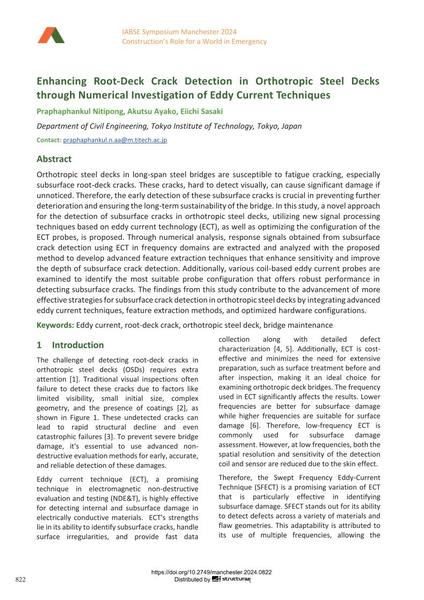Enhancing Root-Deck Crack Detection in Orthotropic Steel Decks through Numerical Investigation of Eddy Current Techniques

|
|
|||||||||||
Bibliographic Details
| Author(s): |
Praphaphankul Nitipong
(Department of Civil Engineering, Tokyo Institute of Technology, Tokyo, Japan)
Akutsu Ayako (Department of Civil Engineering, Tokyo Institute of Technology, Tokyo, Japan) Eiichi Sasaki (Department of Civil Engineering, Tokyo Institute of Technology, Tokyo, Japan) |
||||
|---|---|---|---|---|---|
| Medium: | conference paper | ||||
| Language(s): | English | ||||
| Conference: | IABSE Symposium: Construction’s Role for a World in Emergency, Manchester, United Kingdom, 10-14 April 2024 | ||||
| Published in: | IABSE Symposium Manchester 2024 | ||||
|
|||||
| Page(s): | 822-830 | ||||
| Total no. of pages: | 9 | ||||
| DOI: | 10.2749/manchester.2024.0822 | ||||
| Abstract: |
Orthotropic steel decks in long-span steel bridges are susceptible to fatigue cracking, especially subsurface root-deck cracks. These cracks, hard to detect visually, can cause significant damage if unnoticed. Therefore, the early detection of these subsurface cracks is crucial in preventing further deterioration and ensuring the long-term sustainability of the bridge. In this study, a novel approach for the detection of subsurface cracks in orthotropic steel decks, utilizing new signal processing techniques based on eddy current technology (ECT), as well as optimizing the configuration of the ECT probes, is proposed. Through numerical analysis, response signals obtained from subsurface crack detection using ECT in frequency domains are extracted and analyzed with the proposed method to develop advanced feature extraction techniques that enhance sensitivity and improve the depth of subsurface crack detection. Additionally, various coil-based eddy current probes are examined to identify the most suitable probe configuration that offers robust performance in detecting subsurface cracks. The findings from this study contribute to the advancement of more effective strategies for subsurface crack detection in orthotropic steel decks by integrating advanced eddy current techniques, feature extraction methods, and optimized hardware configurations. |
||||
| Keywords: |
orthotropic steel deck bridge maintenance eddy current root-deck crack
|
||||
